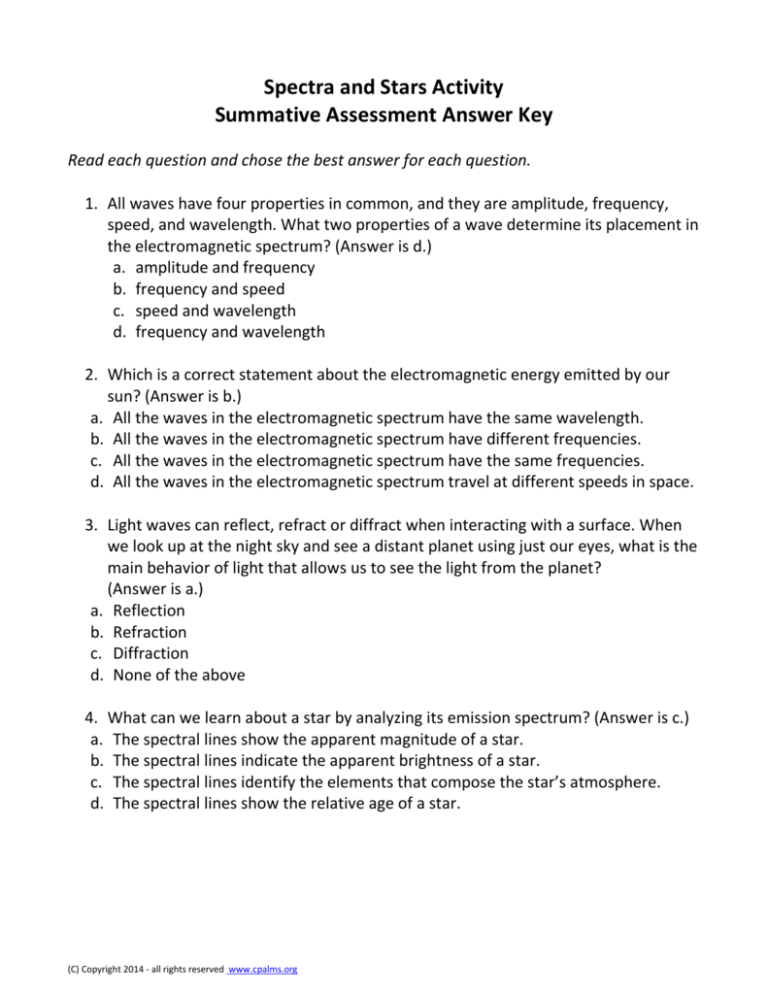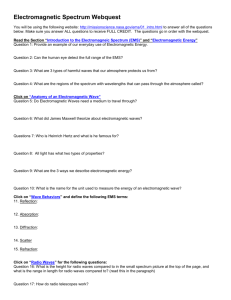
Spectra and Stars Activity
Summative Assessment Answer Key
Read each question and chose the best answer for each question.
1. All waves have four properties in common, and they are amplitude, frequency,
speed, and wavelength. What two properties of a wave determine its placement in
the electromagnetic spectrum? (Answer is d.)
a. amplitude and frequency
b. frequency and speed
c. speed and wavelength
d. frequency and wavelength
2. Which is a correct statement about the electromagnetic energy emitted by our
sun? (Answer is b.)
a. All the waves in the electromagnetic spectrum have the same wavelength.
b. All the waves in the electromagnetic spectrum have different frequencies.
c. All the waves in the electromagnetic spectrum have the same frequencies.
d. All the waves in the electromagnetic spectrum travel at different speeds in space.
3. Light waves can reflect, refract or diffract when interacting with a surface. When
we look up at the night sky and see a distant planet using just our eyes, what is the
main behavior of light that allows us to see the light from the planet?
(Answer is a.)
a. Reflection
b. Refraction
c. Diffraction
d. None of the above
4. What can we learn about a star by analyzing its emission spectrum? (Answer is c.)
a. The spectral lines show the apparent magnitude of a star.
b. The spectral lines indicate the apparent brightness of a star.
c. The spectral lines identify the elements that compose the star’s atmosphere.
d. The spectral lines show the relative age of a star.
(C) Copyright 2014 - all rights reserved www.cpalms.org
5. Why do we see colors of light? (Answer: Light or light energy travels in waves. Each
color of light has a different wavelength and frequency. Our eyes can only detect
visible light waves just like a radio telescope can only detect radio waves.)
6. How do we interpret materials based on the color emitted? (Short Answer: The
emission spectrum of the material is analyzed and compared to element's
emission spectrum to determine the best match of the elements present in the
material. Long Answer: Matter will reflect, refract or diffract light waves as waves
hit the material. Based on the properties of the matter, some of the frequencies
(colors) will be absorbed (refracted and never come out) and some will be
transmitted (diffracted). The light that is emitted from a material forms a unique
pattern according to the elements present in matter. This pattern of frequencies is
the emission spectrum of the element. So, by comparing the emission spectrum of
the material to the known lab-tested emission spectrum of the elements, we can
identify the elements present in the material.
7. How do scientists know the composition of stars in distant galaxies? (Answer:
Scientists can identify the elements present in the atmosphere by studying the
absorption spectrum of the star.)
(C) Copyright 2014 - all rights reserved www.cpalms.org
Spectra and Stars Activity
Summative Assessment
Name:_________________
Class Period: ____________
Date:__________________
Read each question and chose the best answer for each question.
1. All waves have four properties in common, and they are amplitude, frequency,
speed, and wavelength. What two properties of a wave determine its placement
in the electromagnetic spectrum?
a. amplitude and frequency
b. frequency and speed
c. speed and wavelength
d. frequency and wavelength
2. Which is a correct statement about the electromagnetic energy emitted by our
sun?
a. All the waves in the electromagnetic spectrum have the same wavelength.
b. All the waves in the electromagnetic spectrum have different frequencies.
c. All the waves in the electromagnetic spectrum have the same frequencies.
d. All the waves in the electromagnetic spectrum travel at different speeds in
space.
3. Light waves can reflect, refract or diffract when interacting with a surface. When
we look up at the night sky and see a distant planet using just our eyes, what is
the main behavior of light that allows us to see the light from the planet?
a. Reflection
b. Refraction
c. Diffraction
d. None of the above
4. What can we learn about a star by analyzing its emission spectrum?
a. The spectral lines show the apparent magnitude of a star.
b. The spectral lines indicate the apparent brightness of a star.
c. The spectral lines identify the elements that compose the star’s atmosphere.
d. The spectral lines show the relative age of a star.
(C) Copyright 2014 - all rights reserved www.cpalms.org
5. Why do we see colors of light?
___________________________________________________________________
___________________________________________________________________
___________________________________________________________________
6. How do we interpret materials based on the color emitted?
___________________________________________________________________
___________________________________________________________________
___________________________________________________________________
___________________________________________________________________
___________________________________________________________________
___________________________________________________________________
7. How do scientists know the composition of stars in distant galaxies?
___________________________________________________________________
___________________________________________________________________
___________________________________________________________________
___________________________________________________________________
___________________________________________________________________
___________________________________________________________________
(C) Copyright 2014 - all rights reserved www.cpalms.org








